IIFT Paper - 2009 - CAT MCQ
30 Questions MCQ Test - IIFT Paper - 2009
Answer the questions based on the following graphs
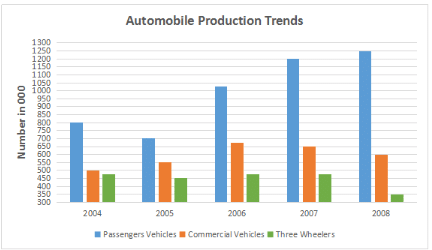
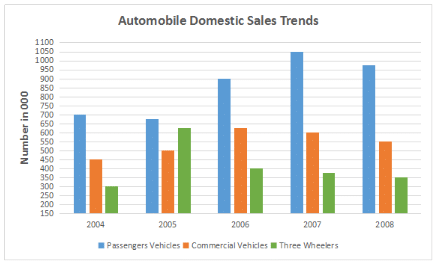
Q. Which of the following year exhibited highest percentage decrease over the preceding year in the automobile production?


Answer the questions based on the following graphs


Q. Assume whatever that is not sold domestically was exported, then which year has registered highest growth in exports of automobiles?


| 1 Crore+ students have signed up on EduRev. Have you? Download the App |
Answer the questions based on the following graphs


Q. If the ratio of the domestic sale price of a commercial vehicle, a passenger vehicle, and a three wheeler is 5 : 3 : 2 then what percent of earnings (approximately) is contributed by commercial vehicle segment to the overall earnings from domestic sales during the period 2004-2008?


Answer the questions based on the following graphs


Q. For which year were the domestic sales of automobiles closest to the average (2004-2008) domestic sales of automobiles?
Answer the questions based on the following graphs


Q. Which of the following years exhibited highest percentage increase over the preceding year in the automobile sales?
Answer the questions based on the following graphs


Q. The ratio between absolute increase in domestic sales over preceding year and absolute increase in production over the preceding year is highest during which year?
Answer the questions based on the following information.
The table below gives the details of money allocation by three Mutual funds namely, Alpha, Beta, and Gama. The return for each fund depends on the money they allocate to different sectors and the returns generated by the sectors. The last column of the table gives return for each of the sectors for a one year period.
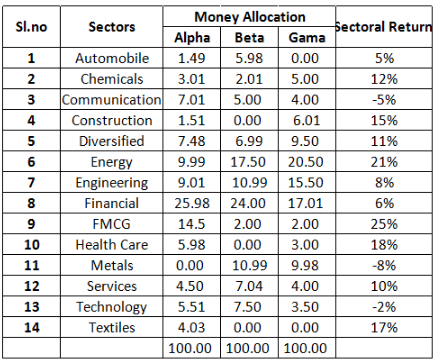
Q. Which fund has received more return per rupee of investment for one year period?
Answer the questions based on the following information.
The table below gives the details of money allocation by three Mutual funds namely, Alpha, Beta, and Gama. The return for each fund depends on the money they allocate to different sectors and the returns generated by the sectors. The last column of the table gives return for each of the sectors for a one year period.

Q.If the allocation of money by the fund managers to different sectors is based on the internal ranking (i.e. Sector with 1st rank gets highest allocation). Sectors with 0 allocation of money should be considered as 14th rank irrespective of the number of sectors in that category. In the light of these examine the following
Statements:
I. Automobile is ranked by both Alpha and Beta as same
II. Financial is most favoured by all three Mutual Funds
III. Services is ranked by all three Mutual Funds within top 9 ranks
Select the best option:
Answer the questions based on the following information.
The table below gives the details of money allocation by three Mutual funds namely, Alpha, Beta, and Gama. The return for each fund depends on the money they allocate to different sectors and the returns generated by the sectors. The last column of the table gives return for each of the sectors for a one year period.

Q. Ms. Hema invested Rs. 10.00 lakhs in fund Gama in the beginning of the period. What will be the value of the investment at the end of 1 year period?
Answer the questions based on the following Table
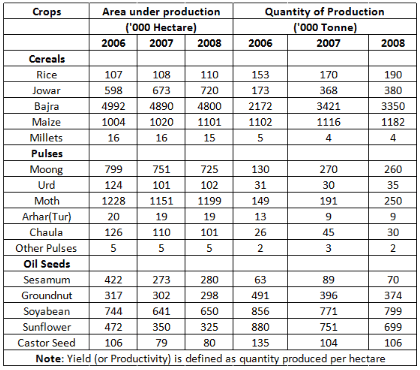
Q. What is the ratio between Jowar yield (2007) and Soyabean yield (2008)?
Answer the questions based on the following Table

Q. Top 3 crops by yield in the year 2006 are:
Answer the questions based on the following Table

Q. Bottom 3 crops by yield in the year 2008 are:
Answer the questions based on the following Table

Q. Examine the following statements:
I. Total productivity of pulses has gone down over the years
II. Maize is the most stable cereal in terms of productivity over the years
III. Percentage growth in area and quantity of production is highest in the case of Jowar during the entrie period. Select the best option:
Answer the questions based on the following Table

Q. Examine the following statements:
I. Over the period total cereal productivity has gone up
II. Area, Production and yield of the total oil seeds is on decline
III. Though there is a decline in the area under Urd production but the quantity of production and yield has gone up over the years.
Select the best option:
Study the following carefully and answer the questions.
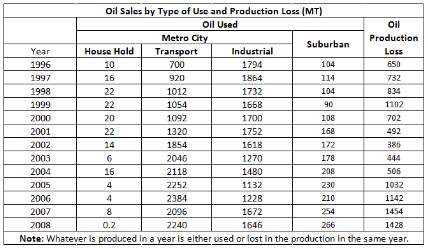
Q. During which year the Oil used for House Hold as a percentage of Total Oil Used is highest?
Study the following carefully and answer the questions.

Q. During which year the ‘Oil Production Loss’ as a proportion of ‘Total Oil Produced’ is the lowest?
Study the following carefully and answer the questions.

Q. During which year use of oil by ‘Suburban’ as a proportion of ‘Total Oil Used’ was the highest?
Study the following carefully and answer the questions.

Q. For how many number of years the growth rate in ‘Production of Oil’ is more than the growth rate in ‘Total Oil Used’?
Study the following carefully and answer the questions.

Q. Which of the below statements are true, based on the data in the above table?
Study the followin information carefully and answer the questions.
Four houses Blue, Green, Red and Yellow are located in a row in the given order. Each of the houses is occupied by a person earning a xed amount of a salary. The four persons are Paul, Krishna, Laxman, and Som.
Read the following instruction carefully:
I. Paul lives between Som and Krishna
II. Laxman does not stay in Blue house
III. The person living in Red house earns more than that of person living in Blue
IV. Salary of Som is more than that of Paul but lesser than that of Krishna
V. One of the person earns Rs. 80, 000
VI. The person earning Rs. 110,000 is not Laxman
VII. The salary difference between Laxman and Son is Rs. 30,000
VIII. The House in which Krishna lives is located between houses with persons earning salaries of Rs. 30,000 and Rs. 50,000
IX. Krishna does not live in Yellow house, and the person living in yellow house is not earning lowest salary among the four persons.
Q. Who lives in Red house?
Study the followin information carefully and answer the questions.
Four houses Blue, Green, Red and Yellow are located in a row in the given order. Each of the houses is occupied by a person earning a xed amount of a salary. The four persons are Paul, Krishna, Laxman, and Som.
Read the following instruction carefully:
I. Paul lives between Som and Krishna
II. Laxman does not stay in Blue house
III. The person living in Red house earns more than that of person living in Blue
IV. Salary of Som is more than that of Paul but lesser than that of Krishna
V. One of the person earns Rs. 80, 000
VI. The person earning Rs. 110,000 is not Laxman
VII. The salary difference between Laxman and Son is Rs. 30,000
VIII. The House in which Krishna lives is located between houses with persons earning salaries of Rs. 30,000 and Rs. 50,000
IX. Krishna does not live in Yellow house, and the person living in yellow house is not earning lowest salary among the four persons.
Q. Which house is occupied by person earning highest salary?
Study the followin information carefully and answer the questions.
Four houses Blue, Green, Red and Yellow are located in a row in the given order. Each of the houses is occupied by a person earning a xed amount of a salary. The four persons are Paul, Krishna, Laxman, and Som.
Read the following instruction carefully:
I. Paul lives between Som and Krishna
II. Laxman does not stay in Blue house
III. The person living in Red house earns more than that of person living in Blue
IV. Salary of Som is more than that of Paul but lesser than that of Krishna
V. One of the person earns Rs. 80, 000
VI. The person earning Rs. 110,000 is not Laxman
VII. The salary difference between Laxman and Son is Rs. 30,000
VIII. The House in which Krishna lives is located between houses with persons earning salaries of Rs. 30,000 and Rs. 50,000
IX. Krishna does not live in Yellow house, and the person living in yellow house is not earning lowest salary among the four persons.
Q. What is the salary earned by person living in Green house?
Mr Raghav went in his car to meet his friends John. He Drove 30 kms towards north and then 40 kms towards west. He then turned to south and covered 8 kms. Further he turned to east and moved 26 kms. Finally he turned right and drove 10 kms and then turned left to travel 19 kms. How far and in which direction is he from the starting point?
Mr. Raju took the members of his family for a picnic. His father’s mother and mother’s father including their two children were in one car. His father’s son and sister’s husband, brother’s wife were in second car. He along with his wife, wife’s sister, wife’s brother and son’s wife with a kid was in the third car. How many members of Mr. Raju’s family were there in the picnic along with Mr. Raju and how many were left behind (assuming all members of the third generation are married)?
ABCDE play a game of cards. ‘A’ tells ‘B’ that if ‘B’ gives him ve cards ‘A’ will have as many cards as ‘E’ has. However if A gives ve cards to ‘B’ then ‘B’ will have as many cards as ‘D’. A and B together has 20 cards more than what D and E have together. B has four cards more than what C has and total number of cards are 201. How many cards B have?
Ganesh Cultural Centre for promoting arts has appointed 3 instructors for music, dance, and painting. Music instructor takes session from 12 noon to 4:00 pm on Monday, Thursday and Sunday. The sessions of dance instructor are scheduled on Tuesday, Thursday, Wednesday and Sunday between 10:00 a to 2:00 pm. The 9:00 am to 12:00 noon slot on Tuesday, Friday and Thursday and also 2:00 pm to 4:00 pm slot on Wednesday, Saturday and Sunday is lled up by Painting Instructor. On which day(s) of a week the dance and painting sessions are simultaneously held?
Study the information given below and answer the questions.
The following table contains the pre and post revision pay structure of a Government department

The revision has been done based on the following terms:
-In pre-revised pay scale, the basic pay is the sum of the minimum pay in the appropriate pay scale and the admissible increment. After revision, the basic pay is the sum of minimum pay in the appropriate pay scale and the respective grade pay and the admissible increments.
-Annual increment of 3% of the basic pay (on a compounded basic) is paid under the revised pay rules.
-Monthly Dearness Allowance (DA) is calculated as percentage of basic pay.
-In pre-revised pay scales, the increment was given after the completion of each year of service, but, after revision annual increments are given only in the month of July every year and there should be a gap of six months between the increments.
The employees who had joined the department in the month of September, October, November and December are given an increment at the time of revised pay xation in September, 2008.
The revised pay is applicable from 1st September, 2008.
Q. Abhijit joins the department on November 10, 2006 in the pay scale of Rs. 18,400-500-22,400 with the pay of Rs. 18,400 plus 2 increments. What is his basic salary, after revision, on August 1, 2009?
Study the information given below and answer the questions.
The following table contains the pre and post revision pay structure of a Government department

The revision has been done based on the following terms:
-In pre-revised pay scale, the basic pay is the sum of the minimum pay in the appropriate pay scale and the admissible increment. After revision, the basic pay is the sum of minimum pay in the appropriate pay scale and the respective grade pay and the admissible increments.
-Annual increment of 3% of the basic pay (on a compounded basic) is paid under the revised pay rules.
-Monthly Dearness Allowance (DA) is calculated as percentage of basic pay.
-In pre-revised pay scales, the increment was given after the completion of each year of service, but, after revision annual increments are given only in the month of July every year and there should be a gap of six months between the increments.
The employees who had joined the department in the month of September, October, November and December are given an increment at the time of revised pay xation in September, 2008.
The revised pay is applicable from 1st September, 2008.
Q. Nitin joined the department on November 24, 2004 in the pay scale of Rs. 8,000-275-13,500, at the minimum pay. At the time of pay revision, due to some error, his pay was xed at the base (minimum) of the corresponding revised pay scale. The loss in his total emoluments for September 2008, due to this error, will be
Study the information given below and answer the questions.
The following table contains the pre and post revision pay structure of a Government department

The revision has been done based on the following terms:
-In pre-revised pay scale, the basic pay is the sum of the minimum pay in the appropriate pay scale and the admissible increment. After revision, the basic pay is the sum of minimum pay in the appropriate pay scale and the respective grade pay and the admissible increments.
-Annual increment of 3% of the basic pay (on a compounded basic) is paid under the revised pay rules.
-Monthly Dearness Allowance (DA) is calculated as percentage of basic pay.
-In pre-revised pay scales, the increment was given after the completion of each year of service, but, after revision annual increments are given only in the month of July every year and there should be a gap of six months between the increments.
The employees who had joined the department in the month of September, October, November and December are given an increment at the time of revised pay xation in September, 2008.
The revised pay is applicable from 1st September, 2008.
Q. Sunitha joined the department at the basic pay of Rs. 13,500 in the pay scale of Rs. 12,000-16,500. On completion of her four years of service in December, 2008, she was promoted to the next higher pay scale, the percentage increase in her gross salary is:
Study the information given below and answer the questions.
The following table contains the pre and post revision pay structure of a Government department

The revision has been done based on the following terms:
-In pre-revised pay scale, the basic pay is the sum of the minimum pay in the appropriate pay scale and the admissible increment. After revision, the basic pay is the sum of minimum pay in the appropriate pay scale and the respective grade pay and the admissible increments.
-Annual increment of 3% of the basic pay (on a compounded basic) is paid under the revised pay rules.
-Monthly Dearness Allowance (DA) is calculated as percentage of basic pay.
-In pre-revised pay scales, the increment was given after the completion of each year of service, but, after revision annual increments are given only in the month of July every year and there should be a gap of six months between the increments.
The employees who had joined the department in the month of September, October, November and December are given an increment at the time of revised pay xation in September, 2008.
The revised pay is applicable from 1st September, 2008.
Q. Dinesh joined on July 1, 2008 in the pay scale of Rs. 16,400-20,000 at the basic pay of Rs. 16,850. On August 10, 2009, the department revised the rates of DA to 31% with effect from January, 2009 and further to 36% effective from July 2009. How much arrear will Dinesh get in August, 2009 because of these revisions?

















